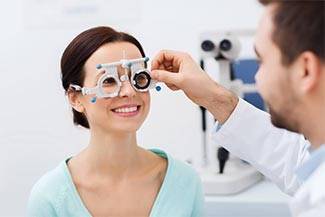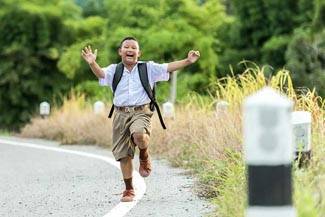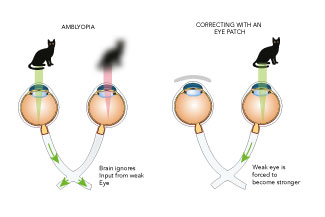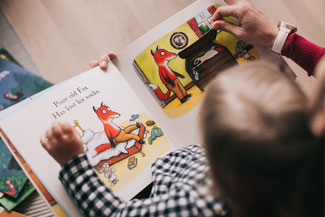VISION RELATED LEARNING PROBLEMS—LEARN THE SIGNS
The connection between good vision and success in school is undisputed. Experts say that about 80 percent of what a student learns in school is information that is presented visually. We live in a visual world. So good vision is essential for a student of any age to reach his full potential and find success in the school setting.
If your child is not succeeding in school, ruling out vision problems should be one of your first steps. Our doctors have the skills and expertise to identify if a vision problem is interfering with your child’s ability to access information and participate fully in school and in after-school activities.

Struggling with homework? It could be vision related
Have your child take our quiz to discover if he/she has functional vision issues that stand in the way of his academic achievement and quality of life.

Watch for these symptoms
Your child may be nearsighted (can’t see far away objects like a blackboard), farsighted (can see objects that are close such as reading a book) and have an astigmatism (a blurring caused by the eyes inability to focus light appropriately).
Watch for these symptoms in conjunction with school challenges:
- Headaches or eye strain
- Blurred vision or double vision
- Crossed eyes or eyes that appear to move independently of each other
- Dislike or avoidance of reading and close work
- Short attention span during visual tasks
- Turning or tilting the head to use one eye only, or closing or covering one eye
- Placing the head very close to the book or desk when reading or writing
- Excessive blinking or rubbing the eyes
- Losing place while reading, or using a finger as a guide
- Slow reading speed or poor reading comprehension
- Poor eye-hand coordination
Is Vision Therapy Right for Your Child?
Having your student’s eyes checked is fast, easy and can relieve a lot of worries and guess work as you help to have him succeed in school.
People with vision-related learning disorders form a large component of those treated with vision therapy. Vision is a complex process of both innate and learned skills, and when one or more of these skills are missing, vision-related learning delays may occur. These delays may occur independently or in conjunction with conditions such as strabismus, dyslexia, ASD, cerebral palsy, and Down’s syndrome. It is possible to learn the missing skills through vision therapy, mitigating or eliminating the vision portion of the learning delay.
The issue at hand is not as much a physical deficiency, but the disconnect between how our brain and eyes communicate. Vision therapy is a type of physical therapy for the eyes and brain, and is a highly effective, non-surgical treatment for the conditions above. By identifying and working through scientifically supported procedures under the supervision of an eye doctor, a patient can restore and improve their fundamental visual skills and abilities.

Our Vision Therapy Services:
- Children often struggle with learning and sports as a result of undiagnosed vision problems — most commonly Convergence Insufficiency (CI). CI has been shown to affect a child’s reading ability, attention and overall school performance. Learn how vision therapy can treat this condition thereby leading to more success in school, work and in sports.
- Amblyopia or “lazy eye” is a neuro-developmental vision condition that begins in early childhood. Strabismus, also known as an “eye turn” or “cross-eye”, is a condition characterized by the improper alignment of the eyes.
- Children with undetected vision problems can struggle with reading and writing, which can adversely affects their studies and quality of life. Read on to find out the ways a developmental optometrist can help.
- Children with special needs are more prone to developing vision problems than the general population. These visual deficits often hamper their academic achievements. Read on to learn how vision therapy can help these children achieve their full potential.
- Just because someone has 20/20 vision, doesn't mean that they can see well. A large percentage of students pass vision screenings with flying colors, yet still experience serious functional vision issues impacting development, life functions and learning. Only a Functional Vision Exam can evaluate whether all essential visual skills are working correctly.
- Amblyopia, commonly referred to as Lazy Eye, occurs when the brain and the eye are not working in unison, resulting in decreased vision in an eye that otherwise seems healthy. The only treatment available which treats the amblyopia and not just the symptoms is Vision Therapy, also called Development Optometry.
- Good vision is so much more than 20/20. A vision screening measures visual acuity only but does not uncover vision deficiencies, such as poor focus or tracking problems, convergence insufficiency, and other essential functional vision skills. These can have a profound effect on your child’s learning abilities and overall success in life.
- Keep Up-To-Date with our Vision Therapy Blog!
- By training the eyes and brain to seamlessly work together, vision therapy effectively treats visual dysfunctions that interfere with a child’s reading and learning abilities.
- Meniere’s disease, a vestibular problem, can be exacerbated by issues related to the visual system. Vision therapy can help reduce dizziness related to visual dysfunction and offer some relief to patients suffering from Meniere’s disease.
- Those with Down syndrome (DS) can experience a range of visual problems and disorders, and can be at risk of developing vision-robbing ocular diseases, such as glaucoma. Read on to learn more and find out how vision therapy can help.
- Poor visual skills can affect many areas of life and can negatively impact performance at school, the office and on the sports field. Read on to find out the most common visual efficiency problems, and how vision therapy can help.
- Vision therapy helps strengthen the connection between the eyes, brain and body with prescribed at-home and in-office eye exercises.













